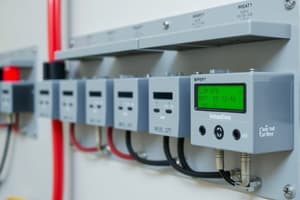Podcast
Questions and Answers
A domestic electrical installation requires the addition of 10A socket outlets to an existing final sub circuit. To meet AS3000 Part 1 safety principles, what is required from AS3000 Part 2? (Select TWO)
A domestic electrical installation requires the addition of 10A socket outlets to an existing final sub circuit. To meet AS3000 Part 1 safety principles, what is required from AS3000 Part 2? (Select TWO)
- The installation work is considered an alteration (correct)
- RCD protection is required for the affected circuit (correct)
- The installation work is considered a repair
- RCD protection is not required for the affected circuit
- RCD protection is required to be added to all the existing final sub circuits
Select THREE methods that provide protection against direct contact.
Select THREE methods that provide protection against direct contact.
- Placing out of reach (correct)
- Obstacles (correct)
- Automatic disconnection of supply
- Barriers (correct)
- Electrical separation
Select FOUR methods that provide protection against indirect contact.
Select FOUR methods that provide protection against indirect contact.
- Electrical separation (correct)
- Insulation
- Barriers
- Automatic disconnection of supply (correct)
- Use of ELV (correct)
- Use of Class II equipment (correct)
What is the temperature limit in normal service for parts of hand-held metallic electrical equipment within arm’s reach?
What is the temperature limit in normal service for parts of hand-held metallic electrical equipment within arm’s reach?
Overcurrents that are likely to arise in live conductors can be protected against by: (Select TWO)
Overcurrents that are likely to arise in live conductors can be protected against by: (Select TWO)
Protective earthing conductors and any other parts intended to carry an earth fault current shall be capable of carrying that current:
Protective earthing conductors and any other parts intended to carry an earth fault current shall be capable of carrying that current:
Disconnected unused conductors in an electrical installation that remain associated with live conductors:
Disconnected unused conductors in an electrical installation that remain associated with live conductors:
An electrical installation must provide reasonable safety from: (Select THREE)
An electrical installation must provide reasonable safety from: (Select THREE)
Protection against the spread of fire is achieved by correct selection and installation of equipment and maintenance of fire barriers.
Protection against the spread of fire is achieved by correct selection and installation of equipment and maintenance of fire barriers.
To protect against injury from mechanical movement every motor shall be provided with a switching device capable of performing which function?
To protect against injury from mechanical movement every motor shall be provided with a switching device capable of performing which function?
AS/NZS 3000:2018 Clause 1.5.14 requires that an electrical installation must be designed to protect against external factors by providing:
AS/NZS 3000:2018 Clause 1.5.14 requires that an electrical installation must be designed to protect against external factors by providing:
To ensure electrical equipment is adequately protected by compliant protection arrangements, electrical equipment must be installed using safe and sound work practices including appropriate construction and operating characteristics to protect against: (Select THREE)
To ensure electrical equipment is adequately protected by compliant protection arrangements, electrical equipment must be installed using safe and sound work practices including appropriate construction and operating characteristics to protect against: (Select THREE)
What type of safety protection is required to protect a person from electric shock when they have come into contact with a conductive part that is not normally live but has become live under fault conditions?
What type of safety protection is required to protect a person from electric shock when they have come into contact with a conductive part that is not normally live but has become live under fault conditions?
One approach to ensure installed electrical equipment meets essential safety requirements is to confirm it satisfies the requirements of:
One approach to ensure installed electrical equipment meets essential safety requirements is to confirm it satisfies the requirements of:
With regard to the operating characteristics of electrical equipment, every item shall be selected and installed to ensure compliance with the following: (Select FOUR)
With regard to the operating characteristics of electrical equipment, every item shall be selected and installed to ensure compliance with the following: (Select FOUR)
Under AS/NZS 3000:2018 clause 7.4.3, all live parts of a separated circuit shall be reliably and effectively electrically:
Under AS/NZS 3000:2018 clause 7.4.3, all live parts of a separated circuit shall be reliably and effectively electrically:
Flashcards are hidden until you start studying
Study Notes
Safety Principles in Electrical Installations
- Domestic electrical installations may require additional socket outlets; in older circuits without RCD protection, adherence to AS3000 standards is crucial.
- RCD protection is essential for affected circuits after alterations, and repair work on circuits should observe safety guidelines.
Protection Against Direct and Indirect Contact
-
Methods for protection against direct contact include:
- Placing circuits out of reach
- Using barriers
- Installing obstacles
- Electrical separation and automatic disconnection of supply serve as safety measures.
-
Protection against indirect contact can be achieved through:
- Class II equipment use
- Insulation
- Electrical separation
- Employing equipment with extra-low voltage (ELV) systems.
Temperature Limits and Overcurrent Protection
- Handheld metallic electrical equipment must maintain a maximum temperature of 55°C during normal operation.
- Protection against overcurrents can be achieved via:
- Automatic disconnection during overcurrent events
- Limiting overcurrent to safe values and durations.
Earthing and Conductors
- Protective earthing conductors must withstand earth fault current without excessive temperature increases.
- Disconnected unused conductors should be terminated and protected like live cables.
Compliance and Safety Measures
- Electrical installations must comply with AS/NZS 3000:2018, ensuring safety from electric shocks, fire hazards, and physical dangers.
- Protection against fire spread is confirmed through proper equipment selection and the maintenance of fire barriers.
Motor and External Factors Protection
- Every motor requires an isolation device for safe maintenance and operation, including emergency stopping capabilities.
- Installations must be safeguarded against mechanical damage and external factors per AS/NZS standards.
Equipment Protection Standards
- Electrical equipment must be installed with attention to mechanical influences, condensation, and environmental hazards.
- Fault protection is critical for preventing electric shock in conductive parts that may unintentionally become live during faults.
Compliance with Safety Requirements
- To ensure safety and functionality, equipment should meet the AS/NZS 3820 requirements.
- Compliance with operating characteristics involves considerations of:
- Voltage rating, design current, and earth leakage current.
- Frequency and prospective short-circuit current should also be taken into account.
Circuit Separation
- Under AS/NZS 3000:2018, live parts of separated circuits must be effectively separated from all other circuits and earth to prevent unintended contact or faults.
Studying That Suits You
Use AI to generate personalized quizzes and flashcards to suit your learning preferences.





